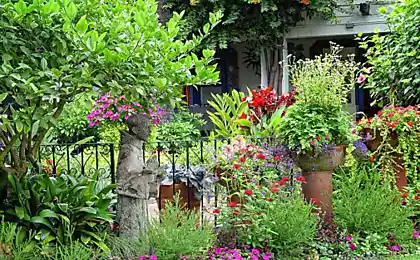170
Why keeping a fern at home is a bad omen
How does the fern bloom? It is known that those who find his mystical flower on the night of Ivan Kupala will discover all the secrets hidden in the bowels of the earth. The search has lasted for hundreds of years and has not yet yielded any results.

And this is not the only mystery associated with the inhabitant of moist shady forests. Our ancestors made legends about him. It was used in various rituals. His name is still surrounded by myths and superstitions, which we want to tell our readers.
Ferns are one of the oldest inhabitants of our planet. Their cirrus leaves grew under the shadow of moist shady forests even in those days when dinosaurs reigned supreme on Earth.

More than 10,000 species of ferns have survived to this day. They grow on every continent except Antarctica. Contrary to legend, none of them bloom. And no wonder: not referring to seed plants, ferns simply can not have either flowers or seeds.

Like horsetails and mosses, they multiply by spores located on the back of the leaves. For most people, this is unusual, because “all plants bloom.” Strange and unusual is alarming. Hence legend and superstition.
According to one of them, the fern blooms only once a year, on the night of Ivan Kupala. In addition, it is very difficult to pick his flower: all the dark forces are trying to prevent this. At midnight, a flower bud rises between wing-like leaves. Opening, she reveals to the world a fiery flower that illuminates everything around.

It is believed that a person who has overcome fear and managed to find a fern flower becomes subject to all secrets and charms. He begins to understand the language of flowers and birds, trees and animals, and can become invisible. And most importantly, he begins to see through the ground and, of course, finds all the treasures hidden in the ground.

Well, despite the skepticism of scientists, let us hope that this legend still has a true grain. Who knows, maybe one day luck will smile on you. And found a miracle flower will help to realize the most cherished desires.
Why rumor does not tell you to start a fern on the site Unpretentious and shadow-loving ferns are perfect for the design of garden plots. Often they serve as a background and frame of flower beds, fences, paths and suburban buildings.

But in some cases, on the way of using ferns there is an insurmountable barrier of superstition. Allegedly, the fern attracts evil spirits. In general, the plant is evil and unfriendly.
7527000
Perhaps this is because the leaves of some ferns can be poisonous to animals. However, most species do not pose any threat. Moreover, they are widely used for medical purposes.

And the young undeveloped shoots of the fern (known as snails, or rachis) are generally edible. So, eagle and ostrich snails (a type of fern) are a traditional dish in the northern United States and Canada.
A house guard? According to some beliefs, a fern is able to bring good luck to the house, according to others, on the contrary, it is a continuous negative. It is said that for normal growth it needs a lot of energy, which the plant takes from the surrounding space like a vampire.

People growing this plant may develop allergic reactions (possibly due to spores) and severe headaches. According to the same legends, fern has a beneficial effect on people with increased temper and aggressiveness.
Bottom line: if you have a large family and do not have a tendency to allergies, then fern is your choice. In England, for example, the fern is considered a talisman that helps to win love. It is often planted together by couples in love or people who dream of reciprocity.
The fern flower is a popular solar symbol among the Slavs. Our ancestors believed that his image, embroidered on fabric, brings the owner good luck, promotes the disclosure of talents and spiritual forces, fulfills cherished desires. Try to grow a fern in your apartment and you will also feel its magical power!
Fern and rodents "What to plant near the house?" - I asked on the phone to an elderly neighbor. “Plant mint, fern, rue at the threshold, and there will be no mice in the house. I used to have this problem: every year, the mice settled in the winter in the house. I spread the fern leaves all over the house, and since then there has been no such problem. Apparently, the smell of rodent fern categorically does not suit.”

It works on the street as well. Some of our readers cover for the winter grapes, weavey roses, young fruit trees with dry fern leaves, and the traces of mice became less. Compared with poisoned baits, it is more environmentally friendly and at the same time additional insulation.

And this is not the only mystery associated with the inhabitant of moist shady forests. Our ancestors made legends about him. It was used in various rituals. His name is still surrounded by myths and superstitions, which we want to tell our readers.
Ferns are one of the oldest inhabitants of our planet. Their cirrus leaves grew under the shadow of moist shady forests even in those days when dinosaurs reigned supreme on Earth.

More than 10,000 species of ferns have survived to this day. They grow on every continent except Antarctica. Contrary to legend, none of them bloom. And no wonder: not referring to seed plants, ferns simply can not have either flowers or seeds.

Like horsetails and mosses, they multiply by spores located on the back of the leaves. For most people, this is unusual, because “all plants bloom.” Strange and unusual is alarming. Hence legend and superstition.
According to one of them, the fern blooms only once a year, on the night of Ivan Kupala. In addition, it is very difficult to pick his flower: all the dark forces are trying to prevent this. At midnight, a flower bud rises between wing-like leaves. Opening, she reveals to the world a fiery flower that illuminates everything around.

It is believed that a person who has overcome fear and managed to find a fern flower becomes subject to all secrets and charms. He begins to understand the language of flowers and birds, trees and animals, and can become invisible. And most importantly, he begins to see through the ground and, of course, finds all the treasures hidden in the ground.

Well, despite the skepticism of scientists, let us hope that this legend still has a true grain. Who knows, maybe one day luck will smile on you. And found a miracle flower will help to realize the most cherished desires.
Why rumor does not tell you to start a fern on the site Unpretentious and shadow-loving ferns are perfect for the design of garden plots. Often they serve as a background and frame of flower beds, fences, paths and suburban buildings.

But in some cases, on the way of using ferns there is an insurmountable barrier of superstition. Allegedly, the fern attracts evil spirits. In general, the plant is evil and unfriendly.
7527000
Perhaps this is because the leaves of some ferns can be poisonous to animals. However, most species do not pose any threat. Moreover, they are widely used for medical purposes.

And the young undeveloped shoots of the fern (known as snails, or rachis) are generally edible. So, eagle and ostrich snails (a type of fern) are a traditional dish in the northern United States and Canada.
A house guard? According to some beliefs, a fern is able to bring good luck to the house, according to others, on the contrary, it is a continuous negative. It is said that for normal growth it needs a lot of energy, which the plant takes from the surrounding space like a vampire.

People growing this plant may develop allergic reactions (possibly due to spores) and severe headaches. According to the same legends, fern has a beneficial effect on people with increased temper and aggressiveness.
Bottom line: if you have a large family and do not have a tendency to allergies, then fern is your choice. In England, for example, the fern is considered a talisman that helps to win love. It is often planted together by couples in love or people who dream of reciprocity.
The fern flower is a popular solar symbol among the Slavs. Our ancestors believed that his image, embroidered on fabric, brings the owner good luck, promotes the disclosure of talents and spiritual forces, fulfills cherished desires. Try to grow a fern in your apartment and you will also feel its magical power!
Fern and rodents "What to plant near the house?" - I asked on the phone to an elderly neighbor. “Plant mint, fern, rue at the threshold, and there will be no mice in the house. I used to have this problem: every year, the mice settled in the winter in the house. I spread the fern leaves all over the house, and since then there has been no such problem. Apparently, the smell of rodent fern categorically does not suit.”

It works on the street as well. Some of our readers cover for the winter grapes, weavey roses, young fruit trees with dry fern leaves, and the traces of mice became less. Compared with poisoned baits, it is more environmentally friendly and at the same time additional insulation.


















